Whether you’ve been to Europe before or not, sometimes you might find yourself with plenty of time but not plenty of money. If you’ve got at least two weeks and hopefully closer to four weeks, you can still have an amazing experience in some of Europe’s greatest cities on a small budget. If you’ve visited London, Paris, or Rome before, you’ll be happy to know that you can visit many other cities while spending half or even less per day.
The itinerary suggestions below are perfect for two quick weeks. If you have more time this is still a great itinerary to use as a starting place, and you’ll find other places you’ll want to add along the way if you have more time. We use our Europe Backpacker Index to show the price comparisons of the cities suggested. Each of those prices is a typical day’s expenses for someone on a ‘backpacker’ budget. If you prefer 3-star hotels you’ll spend at least a bit more per day, but if you are sharing a cheaper hotel room it can still be shockingly inexpensive. By the way, for your first trip to Europe you probably want to choose England, France, or Italy, and save the cheap ones for your next trip.
Note: This article was last updated in August, 2022.
Best four cheap European cities to visit together
- Berlin, Germany
- Prague, Czech Republic
- Budapest, Hungary
- Krakow, Poland
Each of the cities listed above is strong enough to be the highlight of almost any trip, and fortunately they are relatively close together so they work really well as a group. On the map they sort of form a box, so skipping one is easy, and there are plenty of side stops and trips possible in between for shorter or longer stays.
A version of this itinerary can also be found on my new best Europe itineraries for first-time visitors article.
Best cheap and gorgeous small town to add to your trip
- Český Krumlov, Czech Republic
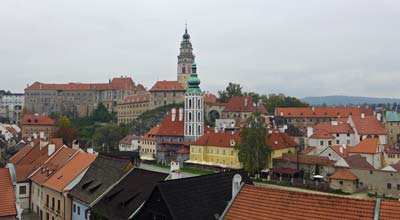
Getting there and back
While none of these cities is among the cheapest in Europe to fly into, at least 3 of them have cheap enough flights that it’s worth flying directly into one of them.
Of the four cities, Berlin will have the cheapest inbound flights from almost anywhere, and Krakow usually only has cheap flights from within Europe. Check flights from your city into each of these cities to see which one will be your cheapest option.
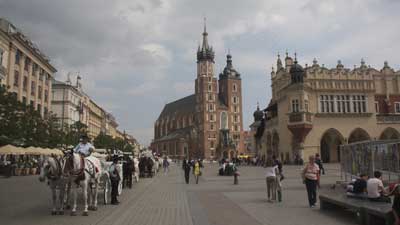
Getting between the cities
There’s little doubt that the most enjoyable way to get between these cities (and most European cities) is by train, but you do have two other main options to consider, namely, flights and buses.
Trains
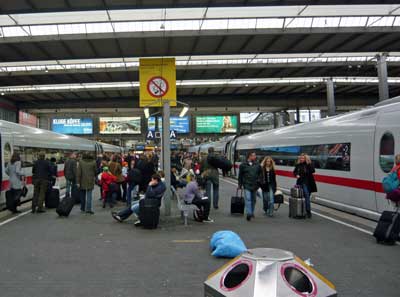
Flights
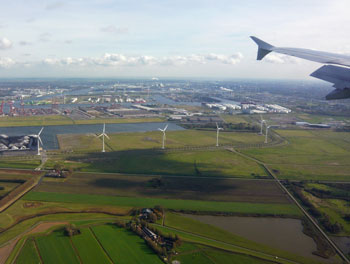
Buses
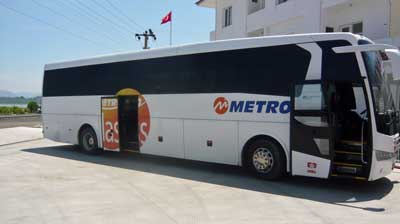
4 Best cheap European cities that are easy to travel between
Below you’ll find the four best cities to use as the foundation of a cheap and wonderful trip to Europe. It’s recommended to spend at least 3 nights in each city, even if you think you are in a hurry.
Berlin, Germany
2022 Backpacker Index: US$64.56/day
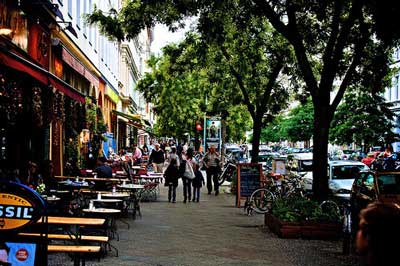
One challenge is that Berlin is a huge and spread-out city, so it’s important to choose where you stay wisely. Most budget travelers will prefer the former East Berlin section around Mitte and Prenzlauer Berg, which is where most hostels are as well as the best and cheapest nightlife and shopping. Check our list of recommended cheap Berlin hotels for a place to start.
What to see and do in Berlin
Start with the Berlin Free Walking Tour on your first morning, and you’ll have enough ideas for what to do for the rest of your stay from that alone. Being honest, the Reichstag (capital building) is a bit disappointing from the inside, although the city does have a handful of great museums clustered together that appeal to many. The Berliner Dom (cathedral) is well worth a visit and you’ll get some great photos from out front.
But mainly Berlin is about exploring the weird and funky neighborhoods for food, shopping, and nightlife. Fortunately, most of it is quite cheap as well. Probably the most famous food to try is currywurst, which is usually a paper tray containing a sliced up hot dog coated in a curry-flavored ketchup. I’m not really a fan, but you should try it, especially after a few beers.
Prague, Czechia
2022 Backpacker Index: US$53.95/day
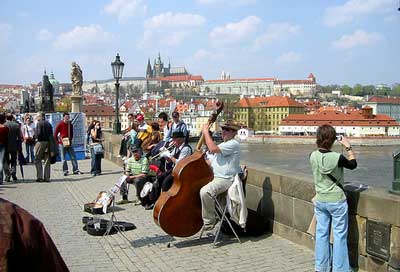
Prague is also fairly compact, with most things walking distance from each other. The city is also quite cheap still, at least compared to Western Europe, although hotel prices can seem high if you want to stay in the middle. Check our list of recommended cheap Prague hotels for some really good ones only a quick and cheap tram ride away.
What to see and do in Prague
Aside from the famous clock in the town square, Prague has a few other very worthwhile checklist attractions. The Prague Castle is one of the largest and most incredible in Europe, and the Charles Bridge and its statues feels like you should have to pay to cross it. As with most European cities, it’s wise to start with a “free” (tips-based) walking tour on your first morning in town. The Prague ones are excellent and in a couple hours you will have seen most of the famous landmarks while hearing the interesting stories behind them. Even a US$10 equivalent tip per person is a great bargain, but tip whatever you feel good about.
There is plenty more to fill a few days, plus you can catch a cheap classical concert in one of the many venues offering them, or just indulge in cheap and excellent beer like everyone else.
Budapest, Hungary
2022 Backpacker Index: US$30.45/day
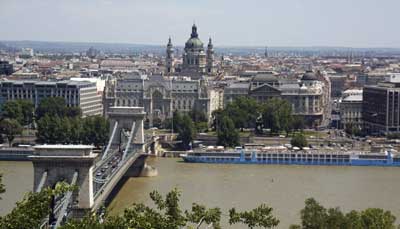
Budapest is also compact enough that budget travelers can stay in the cheap hotels and hostels a bit inland on the Pest side, and still walk everywhere while sightseeing. The Free Budapest Walking Tour covers highlights on both sides, and is a great introduction.
What to see and do in Budapest
During daylight hours, Budapest has the standard selection of monuments and museums in addition to its castle complex, but separates itself from other big cities with its abundant hot springs and spas. Tourists can easily mix with locals and take a dip at a modest fee in one of the unique facilities spread around town.
At night, however, Budapest really comes into its own, with some of the most interesting nightlife in Europe. Head for what are known as “ruin pubs” on the Pest side in the old Jewish Quarter to quaff cheap drinks in converted courtyards that each has its own weird vibe.
Krakow, Poland
2022 Backpacker Index: US$30.72/day
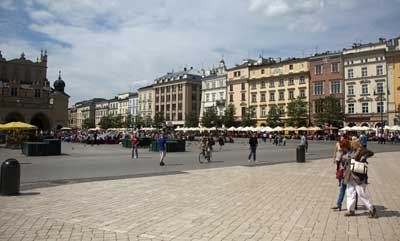
For those who like hearty portions of meats and sausages, Krakow is wonderful, but there are also many Italian and other international cuisines, including many vegetarian options, so something for everyone. Hotels just on or near the central square are reasonable, but you can stay for a lot less by going a few blocks away.
What to see and do in Krakow
As in many other cities, taking the Krakow Free Walking Tour is a great way to get oriented on your first day so you’ll know what you want to explore more deeply. You can also cover many of the main central sights on that tour, which leaves time for day trips and hanging out. Sad though it may be, a half-day trip to nearby Auschwitz is something you’ll never forget, and there is a fun salt mine attraction not far away as well.
In the evening you’ll probably find out why Krakow is very popular with the weekend party and stag-do crowds. You can sip affordable wine at one of the cafes on the square, but it might be more fun to do a pub crawl through the varied drinking establishments in the nearby Jewish Quarter. It’s easy to find a .5L beer for around US$1.50, so getting carried away is common.
Český Krumlov, Czech Republic
2022 Backpacker Index: US$40.47/day
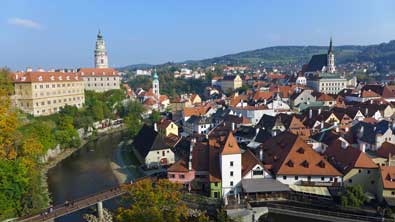
There are almost no chain hotels or restaurants of any kind, so staying here will be a very local experience. Better still, hotels and food here are much cheaper than even in Prague, so the value is outstanding. The historic town center is small enough to walk through in less than 10 minutes, yet you can still get nice hotels in its heart starting at around US$50 per night. As of 2022 the hostels in Český Krumlov are closed so we had to use hotels for the Backpackers Index, which makes the index price artificially higher than it should be. In other words, if you visit this town you’ll find it to be pleasantly affordable.
What to see and do in Český Krumlov
Český Krumlov does have an impressive castle perched above the compact town center, and you’ll definitely want to tour at least part of it. But really the main reason to visit the town is to slow down and appreciate being outside of Europe’s large cities for 2 or 3 days. Those other four cities are always busy and crowded, while this one is gentle and lovely, although you will be surrounded by quite a few other tourists.
As with the other cities on the list, there is a highly recommended free walking tour in Český Krumlov, which is a great place to start. That tour will also show you and explain all of the other worthwhile nearby sights, but I won’t blame you if you just prefer to grab a seat at one of the cheap restaurants with outdoor seating on the main square, and relax over a few delicious and inexpensive beers for a while.
Additional photo credits: Berlin by Philippe AMIOT on Flickr, Prague by POldi♬24 on Flickr

Roger,
Thank you, this helps. I am trying to do too much in the time we have and your information is helping me narrow the trip down. I am glad I found this site. Thank you again, Ann
Hi Roger,
I am planning a 2 week trip to Europe in June.. Mostly from 2nd to 16th. I am from Mumbai, India
Me and my wife will travel and we prefer beach destinations: holiday with atleast 50% beach destinations.. and rest 50% in best places of the respective country..
Did some browsing and found that Greece, Spain, Portugal or Croatia are best.. I dont want a very expensive holiday… something moderately priced or cheap is even better.. but dont want to compromise good places for just expense..
Please suggest which country to visit..I found that June is the best month to visit as most beach destinations tend to get crowded and expensive from July..
I dont want too much of travel in the trip as most experts have advised that too much travel just wastes time.. So I am okay if I cannot cover two countries in the two week visit. I was earlier thinking to club Spain-Portugal or Greece-Croatia..
Is Croatia covered in Schengen visa? If not, is it too complicated?
Awaiting your response.
Regards,
Ashutosh Tripathi
Ashutosh,
I notice that you asked this question on another thread, and that is where I answered it, on the Europe itinerary advice article. -Roger
Roger,
I and my 2 children(19 and 25) have 21 days from June 24-July 16 starting in Vienna (my daughter will be there already for a summer program. We have never been to Europe and would like some suggestions on where to visit. She wants to do northern Italy, Germany, Switzerland, I have family in Novi Sad Serbia, not sure how much we can fit in. Would like to spend time in Vienna of course. Any suggestions would be appreciated. Also, is it crazy of me to consider renting a car?
Ann,
First off, I really wouldn’t recommend renting a car if you mostly want to focus on larger cities. Novi Sad has decent parking, and that’s also true of Interlaken, Switzerland, which is the best hub there. But for the other places a car is really more of a hindrance and the parking will be expensive unless you stay on the edges of towns, and that takes a lot of the fun out of a Europe trip. On the other hand, the trains in Hungary and Serbia are fairly slow, so driving would at least be quicker there. In Germany, Italy, and Switzerland, the trains are much faster than driving.
If you have 21 days I’d recommend choosing 7 places to spend 3 nights each. Novi Sad is a smaller town so you could be okay with 2 nights there, or longer if you want to spend more time with relatives. So let’s say you are spending 3 nights in Vienna and 3 nights in Novi Sad. I just checked now and the train from Vienna to Novi Sad takes a bit over 10 hours, so you might consider flying to Belgrade and going by train or rented car from there, or skipping it if you can put off the visit until a future trip when you’ll be closer.
The other places I’d recommend to consider are Salzburg (2 nights might be enough), Munich, Interlaken, Lucerne (2 nights could be enough if you want to see another Swiss city), and in “northern Italy” you want to visit Venice (1 or 2 nights because it’s quite small) and Florence. It’s only another 2 hours by train from Florence to Rome, and Rome would be perhaps the most memorable stop on this trip, so it’s worth considering.
As for Germany, you might have a look at my article on where to go in Germany for a few more suggestions. Berlin could be a bit out of the way on this trip, but the rest are pretty easy. My article on where to go in Switzerland could also come in handy for that portion.
Just yesterday I finished and posted an article with my 9 best first-time Europe itineraries, which might also help you pick some cities that interest you. I hope this helps and I’m happy to offer more advice as you get your list of places you’d like to visit together. -Roger
Hi Roger,
Thanks for the detailed information. I’m already feeling butterflies in my stomach.
– We are now taking the flight to Prague. We will spend 3 days in Prague.
-2 Days in Cesky Krumlov.
-Overnight train to Budapest. Will spend 3 days in Budapest.
-Flight to Split
The only problem now we have is our return flight is from Prague. In that case, what would you recommend?
Thanks in advance!
BR,
Max
Max,
That sounds like a really nice itinerary. It looks like SmartWings and Czech Airways each sell tickets on a nonstop flight from Split to Prague leaving at 14:40 each day. I think it’s only one plane though, and they seem to charge around US$100 for the one-way trip. Hopefully that works with your flight out because other flights are far more expensive and the train would take forever and be more expensive as well. The only other nearby airports are Dubrovnik and Zagreb, and neither has a decent option, so you should probably buy tickets on the SmartWings flight ASAP. Let me know if you have any other questions. -Roger
Hi Roger,
Many thanks in advance, your posts have helped me a lot.
We are two and would like to visit 3 countries Hungary-Czech Republic-Croatia. We have around 14days which include arriving and leaving Europe. We haven’t booked the flight tickets yet, it would be a great help if you could help us in setting up our itinerary. This would be our first trip outside our country 🙂
thanks in advance!
Max,
I’ll be happy to try to help. If you have 14 days I’d recommend doing 4 or 5 total stops, but if you won’t arrive until late on your first day then 4 stops is probably best. You could do this in reverse, so I’ll give you my best recommendation and you can decide whether to start in the north or the south.
It would be best to fly into Prague and spend 3 or 4 nights there. Then you could take a 3-hour train or bus ride (the bus is actually cheaper and easier) to Cesky Krumlov for 2 nights, if that appeals to you. It’s a small and gorgeous town that is wonderfully cheap considering how nice it is.
From Cesky Krumlov you could take a train to Budapest in about 7 hours. If you skipped Cesky Krumlov, the train from Prague to Budapest also takes about 7 hours. Stay 3 nights in Budapest. The trains in that part of Europe are very slow compared to the western areas, so you are better off flying to Croatia.
The capital city of Zagreb is closer and faster to reach from Budapest, but it’s not very interesting and the whole reason to visit Croatia is to enjoy the coast. So fly to Split and spend the rest of your time there, or nearby. Dubrovnik is similar, smaller, more famous, and much more crowded. So you could go to Dubrovnik instead, but I’d recommend Split. You could then take a ferry to one of the nearby islands just across from Split, or even take a bus down to Dubrovnik (there is no train line).
This should at least give you an itinerary to work with. Let me know if you have any other questions. -Roger
HI Roger
I was wondering if you could help me with the best route to take and what transport is best to take?
I want to include all these 4 cities and cesky crumlov, along with Amsterdam, Copenhagen and Vienna (Maybe) Ill be strtng in Amsterdam more than lkely and was wondering what would be the best route to take?
Ill be going end of May for around 5-6 weeks, am i doing to many cities and should i cut some out?
Many thanks
Aled
Aled,
I can’t really type out a full itinerary for you, but I can give you some advice that I think will help you plan a great trip. You should really plan on spending 3 nights in almost every city you visit, although some smaller places can be visited in 2 nights. Three nights gives you two full sightseeing days, which is enough to see all of the highlights. If you stay only 2 nights you only have 1 full sightseeing day, and that isn’t enough in most cities. If you stay 4 or more nights you’ll start running out of “highlights” and you’ll end up visiting attractions that are way down your list.
So if you have 6 weeks that’s 42 days and you’ll have time for about 13 destinations. On the other hand, 6 weeks is a long time to go at that pace, so I’d probably shoot for maybe 11 or 12 stops, and build in at least one longer relaxation stop in there. A town like Cesky Krumlov is a good one for that because it’s quite cheap, it’s mellow and relaxing, and you can just hang around for a few days without feeling pressure to see all the sights, because there are only a few good ones there.
And you are going to want to take trains for most of this. Czech Republic and Poland are examples of places where bus service is just as fast, cheaper, and more plentiful than trains, but in the other places on your list the trains are faster and more comfortable than buses.
Copenhagen is fairly remote so you might think about flying in and/or out. Or you could also stop in Hamburg, which is quite nice, and the train ride isn’t so long that way. You could go from Amsterdam to Hamburg to Copenhagen to Berlin to Prague to Cesky Krumlov to Vienna to Salzburg, for example. I think once you decide on the cities you want to visit, you can put them on a map and the route will be pretty obvious, at least as long as you choose places that are fairly close to one another. I hope this helps. Let me know if you have more questions and I’ll be happy to help you more. -Roger
Hi, Roger
Thanks for your posts they are very helpful. I’m Brazilian and I’m planning go to Europe for first time with my wife and two children (13 and 8 years old) for a 3 weeks trip or little more. Considering the East itinerary, how long to stay in each country/city (or should I choose less cities due to the kids or another city family friend)?. How much is the cost per day approximately? Thanks in advance for your attention.
I forgot to say: the travel will be in July 2017.
Cristiano,
I’ll be happy to try to help. First off, if this is your first trip to Europe I strongly suggest you consider these 5 great cities. The cheaper cities in the article above are all really worthwhile, but they are a step below cities such as London, Paris, Amsterdam, Venice, and Rome. Those other cities are more expensive, but also more memorable so it would be great if you could mix at least one or two of them into your trip.
My general recommendation is to spend 3 nights in each city, or perhaps 4 nights in the larger and most famous ones. So in 3 weeks you could get to 6 or 7 cities. It’s important to have those two full sightseeing days in each city, partly since it’s hard to get much sightseeing in on the travel days in between.
Your children will be old enough to move quickly on travel days, so I don’t think you really need to slow down much or at all.
One really nice thing about these Eastern cities such as Prague, Budapest, and Krakow is that apartment rentals are very common and fairly cheap. You should be able to find small 1 or 2-bedroom apartments in all of these cities that will be around the same price as a normal hotel room, and much more comfortable.
As far as daily costs are concerned, please have a look at our Europe 3-star Traveler Index. It will be updated for 2017 in the coming few days, but the rankings and prices won’t change much. That list gives you a typical daily price per person for a couple traveling together and staying in 3-star hotels. If you triple that daily price it will probably work as a decent budget for 2 adults and 2 children staying in the same room. It will obviously be cheaper to feed the children, and the admission prices for attractions are also about half the adult price.
Let me know if you have any other questions. -Roger
wanted to travel with my wife , minimum of 18 days most likely paris-amsterdam-berlin-munich-venice -florence-rome-barcelon ….pls suggest if the pace would be ok to travel and how to do intercity transfers, will stay at air bnb and any operator for before hand tickets procurement of prominent sightseeing or activities…regards sahil
Sahil,
Your plan sounds very appealing, but also overly ambitious. I highly recommend 3 nights in each city you visit, with a few smaller cities such as Venice in 1 or 2 days. The rest of them on your list are so filled with big attractions that you’d only be able to see a small fraction before you’d be back on a train. And the other reason to spend 3 nights in most cities is that if you spend only 2 nights in each city it means spending every other day of your holiday on trains and in train stations.
I’d recommend saving some of your stops for a future trip. The best and most memorable ones that are also easiest to string together are Amsterdam, Paris, Venice, Florence, and Rome. If you added Nice after Paris and before Venice you’d have a wonderful look at the south of France and you’d be able to do it all by train. Since you can visit Venice in 1 or 2 days you could still add maybe one more city, as long as it’s along your route. Berlin and Barcelona are both great, but they are a bit out of the way for you.
As mentioned, the train is the best way to get between these cities, and if you buy your tickets online about 2 or 3 months in advance they will be fairly cheap as well. It’s simple to buy tickets for tours and attractions once you get there. If you have any more specific questions, let me know. -Roger
Hi Roger,
My husband and I are planning on a holiday comprising of the following cities Madrid-Barcelona-Berlin-Prague-Vienna-Budapest-Dubrovnik. Also, Athens and Santorini are on my wishlist too. Please guide us on number of days each city you think would require and how to travel between them. I belive a 15-20 day tour should give us enough time to soak in enough of these places. Thanks in advance!
Ruchika
Ruchika,
I recommend 3 nights in each of the cities on your list. If you try to go quicker you’ll end up spending half your time on trains. Even so, your wish list is a bit challenging because many of your destinations are quite spread out. You might want to save Berlin and Dubrovnik for future trips because they are far from your others. Prague is a bit out of the way as well. In fact, you might take another look at the map and see if you can find a couple other stops that are in between your top choices.
It will take you 3 hours by high-speed train from Madrid to Barcelona, but then it would take you all day on a train to get to any of your other cities so you’d want to fly. So long story short, you have great cities on your list, but they are quite spread out. If you substituted some other cities you could get between them by pleasant train rides of 3 to 5 hours. Athens and Santorini are also far from all the others so you’d want to fly. And I recommend 3 days in those as well. Dubrovnik is hard to reach because there are no trains that go there, and flights are kind of expensive. Hopefully this helps. If you have other questions as you work your itinerary out, feel free to ask. -Roger
Hey Roger! What would be an ideal route for the cities you mentioned above? Berlin-Prague-Budapest-Krakow? Also how much time do you suggest we spend on each city? Thanks in advance!
Don,
I’d start in Berlin and then go to Prague, Krakow, and Budapest. The trains on those last two legs are kind of slow, but they are at least fairly inexpensive. I’d recommend 3 nights per city. If you have more time I’d do 4 nights in Berlin and 4 nights in Prague. Krakow is small enough that 3 nights is enough, although many people spend half a day visiting Auschwitz (highly recommended) and half a day visiting the nearby salt mine, so 4 nights could be good if you have them. Let me know if you have any other questions. -Roger